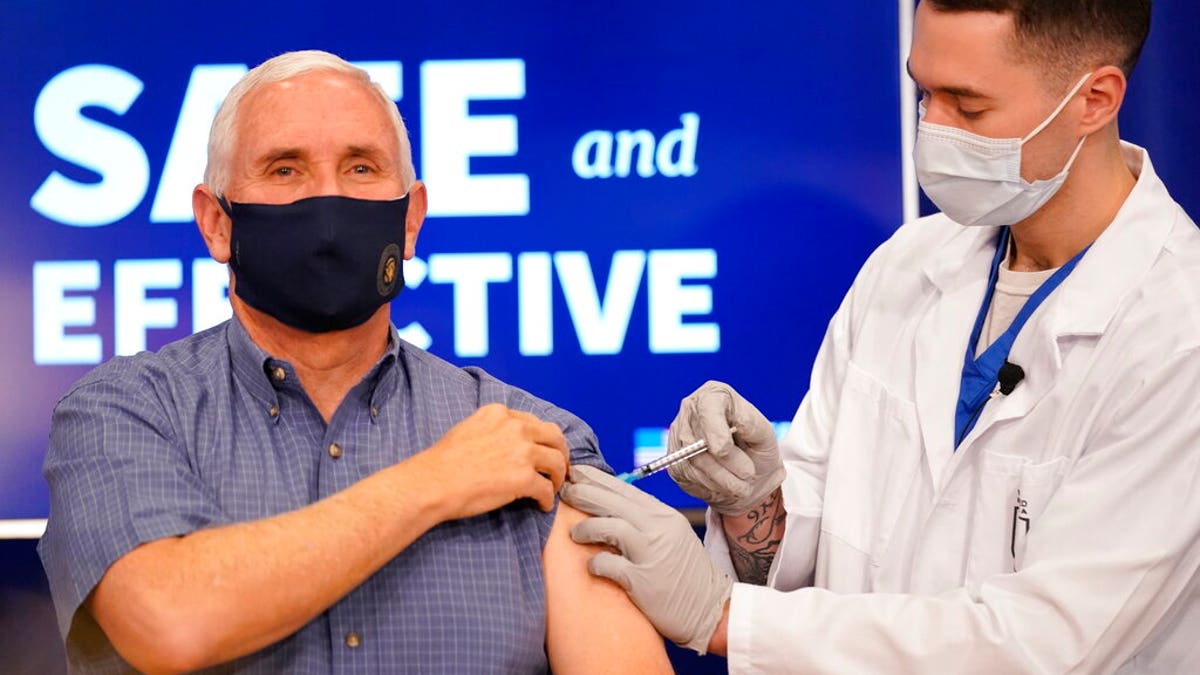Dr. Marc Siegel praises Pence for receiving coronavirus vaccine as 'road out of the pandemic'
Fox News medical contributor Dr. Marc Siegel reacts to Vice President Mike Pence receiving the first dose of Pfizer's coronavirus vaccine.
After the nation’s front-line medical workers and nursing home residents receive the initial COVID-19 vaccines, who should be next in line?
A panelist of medical and public health experts, the Advisory Committee on Immunization Practices (ACIP), advising the Centers for Disease Control and Prevention (CDC) will weigh in and vote on the issue in an emergency meeting this weekend.
The panelists are leaning toward putting "essential workers" first because bus drivers, grocery store clerks and similar employees can’t work from home. They are the people getting infected most often and where concerns about racial inequities in risk are most apparent.
LIVE UPDATES: Today's latest COVID-19 headlines

Vice President Mike Pence receives a Pfizer-BioNTech COVID-19 vaccine shot at the Eisenhower Executive Office Building on the White House complex, Friday, Dec. 18, 2020, in Washington. Second lady Karen Pence and U.S. Surgeon General Jerome Adams also participated. (AP Photo/Andrew Harnik)
But other experts say people age 65 and older should be next, along with people with certain medical conditions. Those are the people who are dying at the highest rates, they say.
The CDC typically endorses advice from the advisory panel, ACIP. That process occurred recently when CDC Director Dr. Robert Redfield upheld the panel’s vote recommending the first doses of the long-awaited coronavirus vaccine should go to health care workers and residents of long-term care facilities.
However, Redfield previously said he looked forward to prioritizing the elderly, over age 70, who reside in multigeneration households. "Often our Hispanic, Black and Tribal Nations families care for their elderly in multigenerational households and they are also at significant risk," Redfield said in an earlier statement.
States don't have to follow the recommendations and each state has already submitted COVID-19 distribution plans to the CDC. Some experts say this patchwork approach, instead of a national immunization plan, could result in some people traveling across state borders to receive vaccinations sooner.

Nurse Kayla Mitchell of Maine Medical Center’s COVID ICU unit in Portland, Maine, becomes the first person in the state to receive the Pfizer-BioNTech COVID-19 vaccine. (Charlie Berg/Maine Medical Center via AP)
Perhaps the agency will recommend giving equal priority to essential workers and older adults, but that would form a priority group that is far, far larger than the number that can be vaccinated before spring.
Estimates count some 87 million essential workers outside of health care, over 53 million older adults and 100 million Americans with underlying medical conditions, though there is some overlap.
For reference, Secretary of Health and Human Services Alex Azar this week projected 20 million Americans vaccinated against COVID-19 by the end of 2020, up to 50 million vaccinated by the end of January and 100 million shots administered between first-dose and booster shots by the end of February.
Meanwhile, various trade organizations have been petitioning to the advisory group to consider prioritizing certain groups of patients, such as the Muscular Dystrophy Association (MDA) advocating on behalf of over 300,000 Americans with neuromuscular diseases like ALS, spinal muscular atrophy and other muscular dystrophies.
In addition to an earlier letter sent to ACIP, the association told Fox News it was communicating priority access for these patients on the ground to state and local health departments.
"MDA is advocating directly to state and local health departments on the needs of the neuromuscular disease community for priority vaccine access within the earliest phases of allocation," Brittany Johnson Hernandez, MDA's senior director of policy and advocacy, wrote in an email to Fox News. "This is an ongoing process as the Federal government and jurisdictions finalize their allocation plans."
Finally, the federal advisory panel’s chairman, Dr. Jose Romero, said the committee is likely to discuss ways to help states narrow down which essential workers should go first. For example, people who are considered essential but can work from home might be placed farther down the list than people who can’t stay 6 feet away from others while on the job.
The Associated Press contributed to this report.


